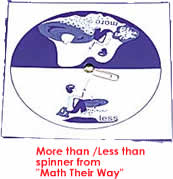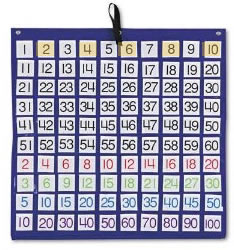Besides learning basic money concepts such as, you need money to buy things and you can earn money by working, children need to learn the names of coins and their value.
Now that purchasing items with debit cards and/or smart phones is so common, many young children have not had as many opportunities to actually see money pass hands or change being made. The following games not only teach the names of the coins but also give children practice in counting and in learning the meaning of more than and fewer than. The games can be adapted for various ability levels.
“Money Line Game”
Children sit in a circle on the carpet. Teacher demonstrates the game first. This game gives children practice in more than, fewer than…
Materials:
- 5 pennies in a small container and a counting mat for each child
- One brown bag with number cards marked 1 – 5 inside,
- A more or less spinner
Procedure:
- Tell the children to choose some or all of their pennies and then put the pennies they choose in a line on their mat. Some will choose all 5 pennies, some 0 pennies, some 3 pennies, etcetera.
- Put the number cards from one to five in the brown bag
- One child picks a card from the bag and puts it on the carpet.

- Teacher (or a child) spins a “more than or less than” spinner.
- If the spinner lands on more than the number taken from the bag, the children that have placed more than that number, jump up and turn around (or any other fun movement). This keeps the focus off winning and losing.
- If the spinner lands on fewer than the number chosen from the bag, the children who have picked fewer than that number jump up and turn around.
This game can be adapted for various ability levels. Use more pennies per child, use nickels or dimes, have older children add the value of the coins they choose. Vary the numbers in the brown bag accordingly.
The Stacking Game – 5s or 10s
Teach kids about money with this stacking game. The game gives children an opportunity to make sets and practice counting by 5s or 10s. As always, demonstrate the game first.
Materials:
- A pile of pennies
- A timer
- Squares of felt (to place on the table to keep the money from sliding around)
Procedure:
- Work with a group of about 5 – 8 children.
- Give each child in the group a pile of pennies on a felt square.
- Start the timer.
- Children make stacks of 10 pennies.
- When the timer rings, have all the children participate in counting by 10s as each child takes a turn touching their stacks of ten.
- Play again. Don’t focus on who stacked the most.
- After a couple of weeks, vary the game by making stacks of 5s or 2s, if you would like the children to learn to count by 5s and 2s.
Teach kids about money by teaching them to skip count

Have the children stand in a circle and raise one hand and count by 5s as you walk around and touch each hand. Have them lift both hands and keep them together when counting by 10s. Vary with fun stuff such as having the kids jump up to tap your hand or clap their hand against yours.
Start slowly and don’t assume that all children know that they have 5 fingers on one hand or 10 fingers on two hands. Daily repetition will give the children skip counting skills so that they will be able to apply them later on in the year with a money unit.
Some children will memorize skip counting quickly, others will need more time. For most young children, this is a rote counting experience, they do not yet have number sense about larger numbers.
Many children find it easier to understand skip counting when they see number lines or charts. The pocket chart above has different colored cards to insert for different skip counting multiples.